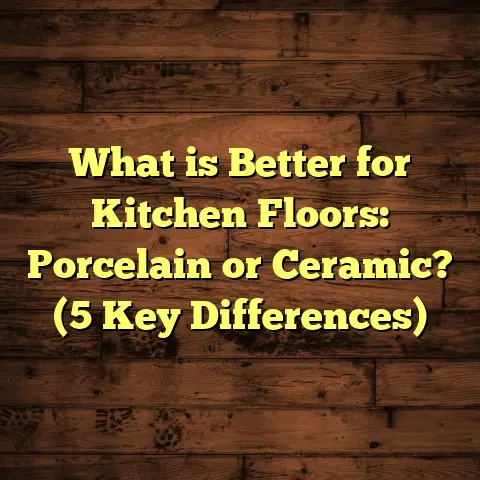What is Healthier: Carpet or Hardwood Floors? (5 Key Benefits)
Did you know that the average person spends about 90% of their time indoors? That means what’s under your feet all day can affect not just your comfort but your health too. I’ve spent years installing and maintaining both carpet and hardwood floors in countless homes, and I’ve seen how much the choice of flooring impacts indoor air quality, allergy symptoms, and even overall wellbeing. It might surprise you to learn how much this decision really matters.
Let’s talk about what makes carpet and hardwood floors different in terms of health and why one might be a better fit for you and your family.
What is Healthier: Carpet or Hardwood Floors?
When people ask me “What is healthier—carpet or hardwood floors?” I always say it depends on what you’re prioritizing. Both have pros and cons, but understanding how each interacts with your home environment helps you make a smarter choice.
Carpet is typically made from woven fibers like nylon, polyester, or wool. It’s soft, warm, and cozy underfoot. Many families love carpet for kid-friendly rooms or bedrooms because it cushions falls and adds sound insulation.
Hardwood floors come from natural timber or layers of wood veneer glued together (engineered hardwood). They’re known for durability, timeless beauty, and ease of cleaning. Hardwood adds a natural aesthetic that many homeowners value.
But beyond looks and comfort, health experts and indoor air quality researchers have studied how these flooring types impact allergens, moisture levels, chemical exposure, and even mental wellness. I’m going to walk you through five key health-related aspects I’ve learned through experience and research.
1. Air Quality & Allergens: Which Flooring Helps You Breathe Better?
If you or someone in your home suffers from allergies, asthma, or other respiratory issues, this is probably the most important factor.
Why does this matter? Carpet acts like a giant filter. It traps dust, pet dander, pollen, mold spores, dust mites, and other microscopic allergens. This might sound good at first because those particles aren’t floating in the air—but here’s the catch: those allergens settle deep inside carpet fibers where vacuums often can’t reach.
A study published by the American Lung Association found that carpets can hold onto allergens much longer than smooth surfaces. Dust mites thrive in carpets because they love warm, humid environments with plenty of dead skin cells to feed on. If you don’t clean carpets regularly and thoroughly with high-quality vacuums equipped with HEPA filters, those allergens build up over time.
I remember working with a family whose young daughter had worsening asthma symptoms every fall and winter. Their home was fully carpeted. After switching the living room and bedrooms to hardwood floors with washable area rugs, their pediatrician noticed reduced wheezing episodes—and the family swore the air felt “cleaner.”
The hardwood floor advantage: Hardwood floors don’t trap allergens like carpet does. Dust, pollen, and pet dander sit on top of the surface where they can be easily swept or mopped away. According to research by the Journal of Allergy and Clinical Immunology, homes with hard surface flooring had significantly lower levels of indoor allergens compared to carpeted homes.
However, hardwood floors do require regular cleaning to remove dust particles. A quick sweep or vacuum with a hard floor attachment once or twice a week usually does the trick.
But there’s a twist: If your hardwood floors are old or damaged with cracks or gaps between planks, dust can accumulate there too. So maintenance matters no matter what flooring you choose.
2. Moisture & Mold Resistance: Preventing Hidden Health Hazards
Mold is a silent but dangerous enemy for indoor health. It can trigger allergies, asthma attacks, respiratory infections, and other chronic health issues.
Carpet can absorb moisture from spills, humidity, or leaks quickly. This creates a perfect environment for mold and mildew growth under the carpet backing or padding—often without you realizing it until you notice a musty smell or spot dampness.
The Environmental Protection Agency (EPA) confirms that carpets in damp environments are more likely to harbor mold spores than hard surface floors. Mold growth hidden beneath carpet can release spores into the air that worsen respiratory symptoms.
From my experience installing flooring in humid climates, I’ve seen too many situations where homeowners had to rip out carpet due to mold contamination—costly and hazardous.
Hardwood floors do better here, especially if properly sealed with moisture-resistant finishes. They don’t soak up water like carpets do. When spills happen on hardwood, they’re usually easy to wipe up before damage sets in.
That said, hardwood isn’t completely immune to water damage. Prolonged exposure to standing water or high humidity can cause wood to warp or swell. That’s why many flooring experts recommend engineered hardwood or water-resistant finishes for areas prone to moisture like kitchens or basements.
In one renovation project I managed, we replaced carpeted basement floors with engineered hardwood sealed with a polyurethane finish designed for moisture resistance. The homeowner reported no mold issues after two years despite the area’s high humidity.
3. Chemical Exposure: What Are We Walking On?
Many people don’t realize their flooring choice affects exposure to chemicals called volatile organic compounds (VOCs). These are gases released from certain materials that impact indoor air quality and health.
Carpets often contain synthetic chemicals from manufacturing processes—flame retardants, stain protectors like perfluorochemicals (PFCs), adhesives for installation, and backing materials. Some of these chemicals off-gas VOCs for months after installation.
According to research published in Environmental Science & Technology, VOCs found in new carpets include benzene and formaldehyde—both linked to headaches, dizziness, respiratory irritation, and long-term health concerns.
I once advised a family who experienced headaches and eye irritation after installing new wall-to-wall carpet throughout their home. After switching to natural fiber rugs on top of hardwood floors and improving ventilation, their symptoms disappeared within weeks.
Hardwood floors also use finishes and adhesives but generally emit fewer VOCs once cured. Choosing natural wood finished with low-VOC or water-based sealants minimizes chemical exposure further.
If you’re sensitive to chemicals or have young children crawling on the floor (who are more vulnerable), hardwood often offers better peace of mind in this area.
4. Comfort vs Cleanliness: Which Flooring Feels Better Without Sacrificing Health?
I get it—carpet feels amazing underfoot. It adds warmth during cold months and muffles noise better than hard surfaces. For homes with toddlers learning to walk or elderly residents prone to falls, carpet naturally cushions impacts.
However, this comfort comes with maintenance responsibilities that affect health indirectly. Carpet needs regular vacuuming with a powerful machine—preferably one equipped with a HEPA filter—to keep allergens down. But even then, deep cleaning every 12-18 months by a professional is recommended to remove trapped dirt and bacteria.
In my early days as a contractor, I installed carpet for a family who didn’t vacuum often enough. Over time they noticed unpleasant odors developing due to bacteria buildup—and their allergies worsened during spring allergy season.
Hardwood floors don’t offer the same cushy feel but are much easier to keep visibly clean. Sweeping daily is simple; mopping weekly helps remove stubborn dirt and allergens.
One client told me her house “felt fresher” after swapping out carpet for hardwood—even though she missed the softness—because she could finally keep dust under control without constant vacuuming struggles.
If comfort is your top priority but you want healthier air quality, using washable area rugs over hardwood floors can be a great compromise. You get softness where you want it plus easier cleaning overall.
5. Longevity & Maintenance: Which Flooring Keeps Your Home Healthier Over Time?
Longevity matters because frequent replacements mean more exposure to new materials and chemicals—and higher costs that might tempt people to delay proper maintenance.
Carpet typically lasts between 5-10 years depending on quality and foot traffic before it becomes worn out or stained beyond salvage. Older carpets tend to harbor more dust mites and allergens simply because of age—even with regular cleaning.
Hardwood floors last decades—sometimes over 50 years—with proper care including refinishing every 7-10 years depending on wear patterns. This longevity means less disposal waste and fewer chances for chemical exposure from new flooring materials over time.
I once visited a historic home where the original hardwood floors had been refinished multiple times but looked stunning after 70 years! The owners loved that their floor was both beautiful and didn’t trap allergens like the old carpets they had replaced decades ago.
Because hardwood floors show dirt more easily than carpet, homeowners tend to clean them more frequently—helping maintain better hygiene overall.
Personal Experiences & Data-Backed Insights
Over my career in flooring installation and consulting:
- I’ve witnessed families improve allergy symptoms by replacing wall-to-wall carpet with hardwood floors.
- Studies back this up: A 2018 survey by the Asthma and Allergy Foundation of America found that 60% of allergy sufferers reported fewer symptoms after switching to hard surface flooring.
- On moisture issues: The EPA reports homes with carpeting in basements have a 40% higher chance of mold problems.
- VOC concerns are real: Research shows new carpets release VOCs at levels 2-3 times higher than hardwood floors during the first six months after installation.
- Maintenance-wise: According to the Carpet & Rug Institute, professional carpet cleaning every 12-18 months reduces allergen load by up to 75%.
Some Myths About Carpet vs Hardwood Health
Let me clear up some common misconceptions I hear all the time:
- Myth: Carpet is always worse because it traps dirt. Truth: Carpet traps dirt but if cleaned regularly with proper equipment (HEPA vacuums + professional steam cleaning), it can be kept fairly allergen-free.
- Myth: Hardwood floors never cause allergies. Truth: Hardwood itself doesn’t cause allergies but accumulated dust on poorly maintained hardwood can trigger symptoms just like carpet.
- Myth: Carpet is cheaper long term. Truth: Initial cost might be lower but replacement cycles + deep cleaning add expenses over time; hardwood may cost more upfront but lasts longer.
The Role of Installation & Maintenance
Regardless of whether you choose carpet or hardwood:
- Proper installation is critical for health outcomes. For example, bad carpet installation can trap moisture under padding leading to mold growth. Hardwood floors installed without proper sealing or vapor barriers in humid areas risk warping or moisture damage.
- Regular maintenance is non-negotiable. Vacuum well on carpeted floors; mop and dust hardwood frequently.
- Air quality benefits are only as good as cleaning habits.
How FloorTally Has Helped Me Manage Flooring Projects
Estimating costs accurately is key when helping clients choose healthier flooring options that fit their budgets.
I use FloorTally often because it consolidates all material prices, labor costs, waste factors, and local rates into one easy platform. This means I don’t have to guess or call multiple suppliers for quotes.
For example:
- When advising a client on switching from carpet to hardwood in their allergy-prone household, FloorTally gave me precise cost breakdowns including premium low-VOC finishes.
- This helped clients see realistic budgets upfront so they could plan financially without surprises—and still get healthier flooring.
- I also use it to compare costs between different carpet types (wool vs synthetic) factoring in maintenance frequency which relates directly to health considerations.
By having all data in one place, I make sure my clients get both affordable AND healthy flooring solutions tailored specifically for their home environment.
Final Thoughts From My Experience
So if you ask me which floor is healthier overall? My vote goes to hardwood floors for most households because:
- They trap fewer allergens
- Resist mold better
- Emit fewer harmful chemicals (with low-VOC finishes)
- Encourage cleaner environments due to easier maintenance
- Last much longer reducing replacement-related exposures
But if softness and warmth are priorities—and you commit to rigorous cleaning—carpet can still be a decent option for bedrooms or low-traffic spaces.
The key takeaway? Whatever floor you choose, invest in good cleaning tools (like HEPA vacuums), schedule regular professional cleanings if needed, maintain proper humidity levels at home (around 30-50%), and address spills immediately.
Your home’s health depends on these habits as much as on the materials beneath your feet!
Have questions about specific brands or need help planning your next flooring project? Just reach out—I’m happy to share more insights based on real-world experience.





